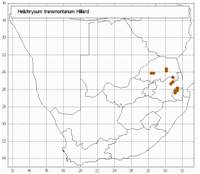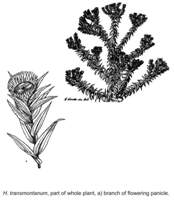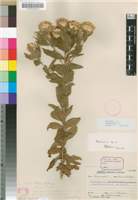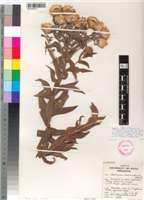Origin of name:
trans = across, over beyond montanum = to do with mountains
Diagnostic characters:
Large solitary headsBrownish bractsLeaves glandular
Description:
Subshrub, stems many from the base, stout, erect to c. 1.5 m, mostly simple below the inflorescence branches, glandular-setose, young parts thinly cobwebby as well, closely leafy. Leaves mostly 50�80 x 20�28 mm, smaller on the inflorescence branches, lanceolate, acute to acuminate, base broad, half-clasping, both surfaces and margins glandular-setose, midline and margins sometimes thinly cobwebby as well. Heads heterogamous or rarely homogamous, 17�20 mm long, about double that across the radiating bracts, broadly campanulate, several in a very open, leafy, terminal corymbose-panicle. Involucral bracts in c. 9 series, graded, imbricate, much exceeding the flowers, glossy, straw-coloured to light brown. Receptacle shortly honeycombed. Flowers c. 600�950, (0�) 5�75 female, 550�920 homogamous. Achenes 0.75�1 mm long, glabrous. Pappus bristles many, equaling the corolla, tip barbellate, shaft barbellate above, scabrid below, base smooth.
Flowering in March and April.
Distribution:
Grows in montane grassland. Recorded only from the highlands of Mpumalanga and W. Swaziland from Duiwelskloof and Woodbush in the north south to Forbes Reef and Mbabane districts in Swaziland.
Savanna Biome.
Notes:
Easily recognized by its very acute to acuminate leaves, large brownish heads and pappus bristles without patent cilia at the base.
Taxonomy:
Literature:
Helichrysum transmontanum Hilliard in Notes R. bot. Gdn Edinb. 40: 268 (1982).
Type:
Limpopo, 2330 CC, Letaba distr., near Haenertsburg, opposite Magoebaskloof Hotel, 13 iii 1981, Hilliard & Burtt 14332 (NU, holo.; E; K; M; PRE; S, iso.).
Synonym(s):
Vouchers:
Codd 7891 (K; PRE); Compton 28553 (K; NBG; PRE); Meeuse 10127 (K; M; PRE); Scheepers 623 (BM; K; M; PRE).


